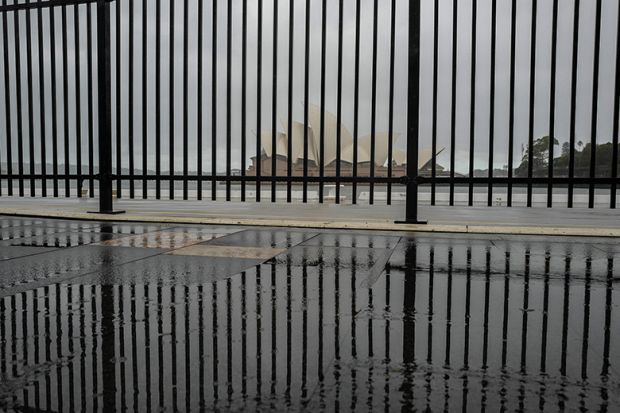Australia’s immigration overhaul could pop its post-Covid international education bubble, experts have warned, as the federal government flags an end to easy migration pathways in policy moves that could have knock-on effects for the global higher education recruitment race.
The newly released migration review has urged the government to “recalibrate” the points test that governs eligibility for permanent residency, to consider imposing tougher English-language requirements on students and graduates, and to limit the time former students can remain in Australia on a temporary basis.
While the government is consulting on the recommendations, it has already outlined plans to reform the points test. And its draft migration strategy promises foreigners “clarity” on their prospects for permanent residence – “whether that means staying here or returning home”.
Higher education researcher Mahsood Shah said changes to immigration settings could affect international enrolments. “The growth of international students is mostly in courses that are linked to migration pathways,” said Professor Shah, dean of Swinburne University’s Sydney campus.
“There is evidence that students from some markets are doing courses that align with skill shortages to get permanent residency, rather than genuinely undertaking the study to contribute to the profession.”
Australia’s international enrolments are rocketing back to pre-pandemic levels, reaching more than 580,000 in January and February this year – just 5 per cent below their previous peak in early 2020, immediately before the pandemic. A record 164,000 foreigners began new courses during the first two months of this year.
Visa processing data suggests student numbers will soon overhaul pre-pandemic levels, with monthly application numbers at record levels for the past year.
But 1 July is shaping up as crunch time for foreign enrolments, as temporary policies that have encouraged growth – the suspension of the cap on overseas students’ paid work hours and the relaxation of limits on online study – suddenly end.
Now the government has announced that changes to the points test will follow. Home affairs minister Clare O’Neil has also flagged unspecified reforms to lift “entry standards” for international students and ensure they are in Australia to study rather than work.
International and tertiary education consultant Claire Field, a former regulator, said these changes were likely to suppress onshore poaching of international students – the practice of “stealing” a student from another institution after they arrive in Australia, which has become the dominant business model of some institutions in vocational education and training (VET), and to a lesser extent in higher education.
But Ms Field said the government crackdown could also undermine more legitimate activities, such as universities catering to foreign students’ desire to extend their skills – and justify their continued stays in Australia – by enrolling in subsequent courses.
She also predicted more prescriptive English requirements for student visa applicants, potentially reducing universities’ discretion over the language skills of their recruits under the simplified student visa framework introduced in 2016.
Ms Field highlighted Ms O’Neil’s acknowledgement, during questioning at the National Press Club, that higher admission standards would have an “inevitable” effect on student numbers. “If a minister tells you that her reforms are likely to have an impact on enrolments, I would believe her,” Ms Field advised.
Jon Chew, head of analytics at Navitas, said inflexible language requirements could be counter-productive: “English is one of the key success factors for a student, and a migrant, but my concern is whether one high-stakes test is the best way to determine [language skills]. It’s important to think holistically about the needs of the students and ensure that providers are there to support them through what is a very challenging experience, whether they’ve got great English or not.”
Mr Chew said it was difficult to judge the likely impact of the government’s changes without more detail of what was proposed. But he endorsed both the intent of the reforms and the way they had been framed, with a focus on “the success of the sector” rather than “anti-student, anti-immigration” messages.
He welcomed policies to curb “temporary” migration with its second-class rights and protections. “We should have clearer pathways to residency; we shouldn’t be stringing people along,” said Mr Chew. “International education is a very strong and successful pathway for the future citizens of Australia. I’d love to see more emphasis on that idea…rather than thinking about it instrumentally or transactionally, around [questions like] what jobs we want to fill and how good your English is.”
When the Australian government overhauled migration rules for international students almost 15 years ago, over signs that desire for residency had skewed study choices and encouraged a proliferation of low-quality courses, foreign enrolments fell by 19 per cent over the following three years.
The impact was mainly in VET, where enrolments crashed by more than a third and took eight years to recover. In higher education, enrolments declined by just 5 per cent and rebounded in four years.
Multiple signs of abuse of the visa system suggest another crackdown is warranted, particularly in VET. An April hearing of a parliamentary committee was told that onshore poaching of students was “out of control”.
Some colleges, the committee heard, were completely reliant on foreigners recruited from within Australia – partly because they had little prospect of recruiting students directly from countries such as Nepal, where 85 per cent of visa applications for vocational study have been rejected since mid-2022. In India, the rejection rate is an extraordinary 94 per cent.
Students use a “Trojan horse” strategy to sidestep this problem, enrolling with universities to secure visas, then switching to cheaper colleges as soon as they reach Australia – in violation of a requirement to maintain their initial enrolments for at least six months. “A whole bunch of students…who are enrolled in a university…never even set foot in the door,” Labor MP Julian Hill told the committee.
The trade is facilitated by “dodgy” agents who charge universities commissions for students recruited from overseas, then extract follow-up commissions of as much as 50 per cent to transfer them elsewhere, the committee heard.
Ms Field said much of this behaviour could have been curbed if government agencies had enforced the six-month rule. Instead, officials had exacerbated the problem by introducing a “loophole” allowing overseas students to enrol simultaneously with two institutions, in a largely unnecessary attempt to facilitate extra study in, for example, bar work or Covid-safe handling practices.
There are signs that international enrolment growth could be checked by developments outside Australia, irrespective of any action Canberra takes. Last month Nepal, Australia’s third-biggest source of foreign students, stopped issuing certificates allowing its citizens to study abroad for sub-degree qualifications.
But any losses could be stemmed by Australian moves to boost policy transparency and simplify a visa regime that Ms O’Neil likened to a “tangled bowl of spaghetti”. Review recommendations likely to appeal to international students include replacing the widely derided genuine temporary entrant (GTE) test with a “genuine student test”, removing unpaid internships from students’ working hours allowances, automatically granting temporary graduate visas upon course completion, and “providing faster pathways to permanent residence”.
Professor Shah welcomed the GTE’s removal and said that an automatic graduate visa would spare students a lot of expensive visa-hopping.
“At present, students have to spend money at every step,” he added.
Register to continue
Why register?
- Registration is free and only takes a moment
- Once registered, you can read 3 articles a month
- Sign up for our newsletter
Subscribe
Or subscribe for unlimited access to:
- Unlimited access to news, views, insights & reviews
- Digital editions
- Digital access to THE’s university and college rankings analysis
Already registered or a current subscriber? Login










